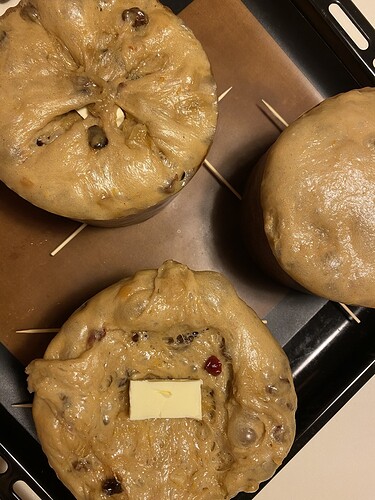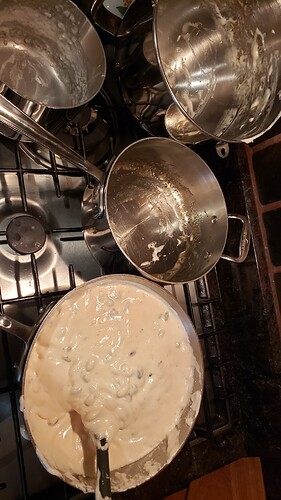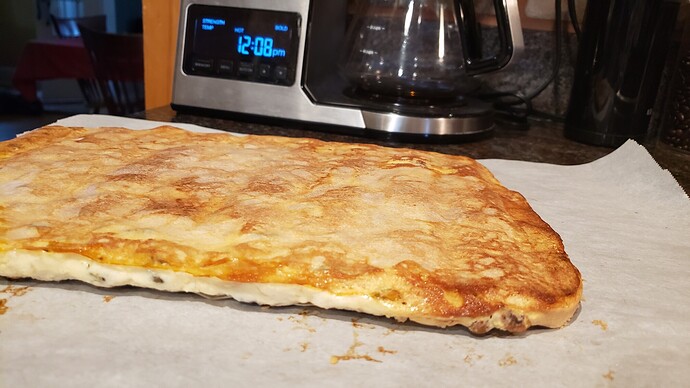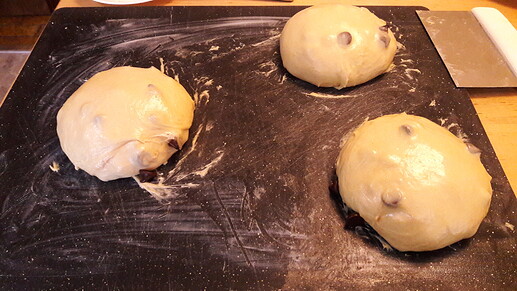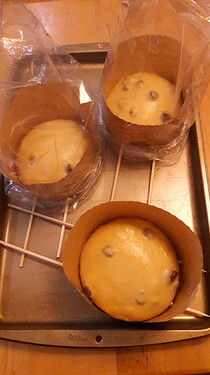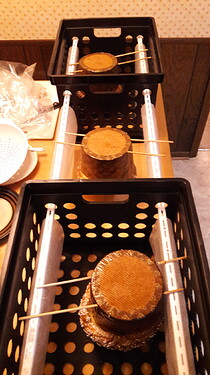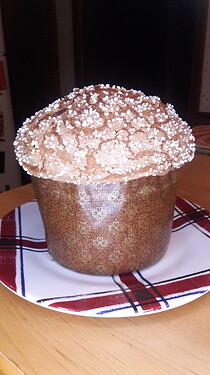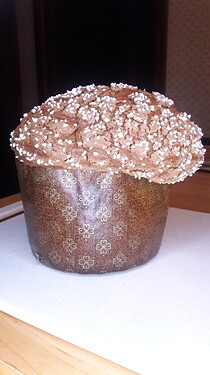Your strategies would likely overcome all the issues I encountered. Another thing that can help keep the sugar syrup from seizing is to add some corn syrup. The simple sugars in the corn syrup interfere with the crystallization of sucrose, so it is much less likely to seize and crystalize. I have seen multiple recipes that include corn syrup, but I didn’t actually have any corn syrup at the time. I do now though. Here is one of the recipes that uses corn syrup:
Spruce Eats Torrone Recipe
The thing I like most about the recipes that use the candy thermometer method is that they don’t require hours of stirring. (but whatever works, right?) Good luck!
Hi Dan,
Need your advice again. In my baking, I have waited for it raise slightly above the top before scoring. The dough did fall a bit during the scoring. But the centre portion juz cave inwards once it is in the oven. My yeast is as active as before and there is no change to my kitchen temp. May I know what’s the main reason?
I suspected 2 possibilities. First, I did the mixing longer to achieve the window pane in day 2. So could it be over mixing and this time, I let it raise for 7.5hrs instead of the usual 6hrs juz to let it raise above the top. Secondly, I made a mistake when I was applying the egg wash. The surface of the dough was wetter than before. Am I right?
Thanks and regards, KL
Hi KL, Sorry to hear about your latest bake. Believe me, I have been there! I have had panettone fall from taking them out of the oven too early to check the temperature, from accidentally slamming the oven door late in the bake and one year I had the tops fall off of all 3 panettone within minutes of inverting them! On the up side, you still get to eat them and they still taste wonderful. (As long as they were actually done in the center- not so with the ones that lost their tops! Mental note: Always measure the temperature BEFORE taking them out of the oven!!! BTW, panettone makes dynamite French toast!)
Anyway, on to the troubleshooting. I have a few questions:
What kind of flour were you using and was it enriched with Vital Wheat Gluten?
Was the egg wash room temp or was the egg fresh out of the refrigerator?
How deeply did you score the tops?
When you say you final proofed until the tops were just above the tops of the molds, was it the center of the dough that was just above the top or was it at the edges? (I always measure at the edges.)
When you say you mixed the second dough for a longer time, did the dough temp stay below 79F?
At what speed were you mixing the second dough?
When you put them in the oven, did you shake/jar them at all?
Sorry for all the questions. Without seeing any of your answers, I suspect possible over proofing, but it could be a lot of things. Hopefully we can better home-in on the issue based on your answers to the above questions.
Hang in there! It took me about 3 years to get this recipe right. Hopefully, learning from my mistakes will get you there a lot faster!
Hi Dan, thanks for your patience in the guidance. I’m appreciative. To answer your questions:
- The bread flour (protein 12%) that I have been using is from Hokkaido, Japan. It is not enriched with Vital Wheat Gluten.
- The egg was fresh out of the refrigerator.
- I scored the tops probably 1/2 inch. Please see photo below. Pardon me for the poor workmanship, I’m really bad at delicate job. The sinking of the centre can’t be due to the weight of the butter right? I added the butter straight from the fridge.
- For the past 3 batches, I always measure at the edge, this time, I measure based on the centre of the dough. I remembered when i removed the cling wrap from the dough, the centre of the dough was touching the cling wrap. To push it further, I decided to let it raise further for another 2.5hrs (my kitchen temperature was around 83F-ish. The reason Im pushing it further because i realised that the skin of the dough took a long while to get hardened for scoring.
- Honestly, I didn’t measure the second dough temperature. But i did put my dough hook in the fridge overnight before using it.
- I’m using a Kitchenaid Artisan stand mixer. This time, I mixed it at Level 2 since the start but I did stop the mixing momentarily and did some manual folding with my spatula especially when adding butter and egg yolks. Once I tested the first sign of window pane, I reduced it to Level 1 when adding the peels and mixed fruits. Again, I stopped the mixing momentarily and did some manual folding as well.
- When i put them in the oven, I didn’t shake/jar them at all.
Honestly, I do agree with you, despite of the bad physical appearance, the bread is still a hit among my friends. I have another question to confirm: does the internal temp needs to reach 201F before it is considered done? The reason I’m asking because if i keep opening the oven door and take it out to test, the oven will lose heat easily. So for a 1 pound dough, I’m baking it in 330F for 40mins. But i do notice that the bread is little bit too ‘moist’. But the idea of leave it in the oven longer freaks me out a little because there is a possibility that it will just dry up.
Once again, thank you for your time. Happy holidays, KL.
Hi KL, here are my thoughts based on your answers:
- While further gluten enrichment (I enrich to ~ 14% protein) can allow for higher risen panettone with a more open crumb, it should not keep you from making a good panettone. I recently made a batch just using 12.7% protein bread flour (due to my mistake) and to my surprise, it still came out ok, just not as high or open as usual. Therefore, I do not think this is the main problem. That said, if you could find some vital wheat gluten, it may be worth trying to use some in the future.
- If you are going to use an egg wash, I would let it come to room temperature before applying it to the risen panettone dough. Applying a cold wash to the warm, risen dough could contribute to causing the dough to fall.
- The highly risen panettone dough is very delicate, so it is important to be as delicate as possible when scoring it. It might be better as you gain confidence to just score and not slice the flaps. And when scoring, you could lubricate the razor blade with water or melted butter to help it cut without dragging through the dough and maybe not quite as deep. Lastly, always use softened, room temperature butter to avoid any thermal shock to the dough.
- My question about how you measured the dough height was just to make sure I understood how high the dough had risen. I do not see any issue here. However, if your dough uses a lower gluten content and you let it rise too high, there is a risk over proofing. In that case, however, I think the dough would rise for a while in the oven but after the aveoli expanded past the point where the gluten could hold the fermentation gasses and popped, then the dough might collapse. I do not think this is the case here since it sounds like your panettone started falling from the start, after scoring, and adding cold egg wash and butter.
- Bowl and hook in fridge should have kept the dough temp OK.
- Mixing looks fine. As long as the dough passed the windowpane test, it should be fine.
- Sounds good!
Lastly, While I consider the panettone to be done when the internal temperature reaches 201F, I do not start checking the temperature until about 5 minutes before I think it will be done. For a 500g panettone (5.25" mold) it takes about 50 minutes at 330F to be done, so I insert a remote read oven thermometer into the center of the loaf at 45 minutes, leaving it in the oven the whole time. I would definitely avoid opening and closing the oven multiple times at the end of the bake. I would not worry too much about the panettone drying out since it is so highly enriched with fats. Probably better to be a little over done than not done enough. Being under-done is what caused the tops to fall out of all my panettone several years ago. Since I made sure the internal temperature is at least 201F, I have never had that problem.
Hope this helps. Best of luck with your next bake!
Hi Dan, thank you much for the time and advice. I will try again this weekend. Fingers crossed. I think there is OCD in every baker for perfection. Happy baking and happy holidays to all!
Quick torrone report:
I carefully timed everything in the recipe from La Cucina Italiana, and the sugar still siezed. I pulled it from the heat at 290F 🤷 I ended up with a lotta goo and actually baked it to make it cutable. Tastes amazing.
I’ll be going back to Chef John’s torrone or that Spruce Eats one. I want to find a way to get the sweetness of the Cucina Italiana recipe though. I looked at the numbers and for the same amount of egg whites, it’s way way less honey.
Mess
Marshmellow-Nut Cake 
Sorry to hear you had a similar result as I did with this recipe, but I feel a little better that I’m not the only one who was challenged. Clever fix to pop it into the oven to salvage the batch. Wish I had been half as on-the-ball as you!
I agree with you about the nice flavor and the more balanced sweetness of the La Cucina recipe. I was really hoping that you would be successful and then let me know the magic solution!  I’m with you though, I would like to figure out how to reduce the sweetness in the Chef John recipe. I’ll probably take another whack at making torrone later in the week, since I plan to try a chocolate panettone bake. I’ll let you know if I have come up with an updated recipe.
I’m with you though, I would like to figure out how to reduce the sweetness in the Chef John recipe. I’ll probably take another whack at making torrone later in the week, since I plan to try a chocolate panettone bake. I’ll let you know if I have come up with an updated recipe.
FYI, the Spruce Eats recipe uses 3 egg whites and 3 cups of sugar. I’ll have to check the numbers, but I now worry that one might be pretty sweet too.
Hi Dan, so glad to find this recipe! I am a little confused on the amount of vital wheat gluten to be added in the recipe. Do you add the vital wheat gluten all at once in the first dough, or do you divide it between the first and second dough. I have King Arthur bread flour at home so I will be using that on my first try, which has 12.7% protein. I am working on the stiff sourdough starter right now, so I should be ready to make my panettone in few days! Can’t wait. Thank you.
Hi @youngle, sorry for the confusion on the addition of vital wheat gluten (VWG). First off, I usually aim for 14.2% protein in my panettone flour, since that was the percent protein in the General Mills All Trumps High Gluten Flour that I originally used to make panettone. After I discovered that enriching bread flour with VWG works just as well, I just take the enrichment route.
I usually just add the appropriate amount of VWG for each dough. So that would be 234g bread flour plus 6g VWG for the first dough (240g total of high gluten flour) and 58g bread flour plus 2g VWG for the second dough (60g total of high gluten flour). Of course, you could just measure out 292g bread flour plus 8g VWG for a total of 300g high gluten flour and then use 240g of the mixture for the first dough and the rest (60g) for the second dough. Make sense?
Happy Holidays and best of luck on your most excellent panettone adventure!
Hi Dan, thank you for your quick response!
Between the two of us and a PDF a friend sent me from a turrón master class in Spain, we will figure this out. I’ll probably try again this weekend, though there is some egg nog snickerdoodle recipe on NYTimes cooking that is also intriguing me. I know we need a different forum thread for torrone, but at this point I think we’re too deep into it here LOL
I’m in the middle of analysing about a half dozen different torrone recipes to try and quantify the sweetness (quantity of sweet ingredients) relative to the number of egg whites. Based on some honey/sugar/corn syrup conversions I found (3/4 cup honey = 1 cup sugar; 1.5 cups corn syrup = 1 cup sugar) I calculate a “sweetness score” and then normalize it to the quantity of egg whites in the recipe. I’m also trying to avoid recipes that require a candy thermometer, since I think we both had some issues with that.
So far, the La Cucina Italiana recipe has the lowest sweetness score. I’m in the middle of final proof for a chocolate panettone (semi sweet and milk chocolate inclusions) tonight but hope to finish my analysis tomorrow so I can use up some leftover egg whites! I’ll share my results with you when I’m done.
I love your idea of a sweetness score!
Dan, thanks so much for the wonderful detailed instructions! I must confess I was a little worried with how much time the dough was spending in the mixer, but holy cow! The result was AMAZING!
A baking adventure so worth the effort! Thank you!
@modbob, congratulations for hanging in there! I know the instructions are pretty daunting when you first see them, but hopefully they make it easier to avoid some of the pitfalls I have encountered over the years. Enjoy your panettone!
Happy Holidays and happy baking!
By the way, sometimes it can take up to 2.5 hours for me to get all the ingredients incorporated into the first dough and up to 2 hours in the second dough. As long as you keep the mixing speed low and frequently monitor the dough temperature, chilling it if/when necessary, it seems to work out just fine.
Wow, that’s crazy. 4 hours of machine time (I love how some of the French Patissiers call them “robots”) for a loaf of holiday bread… but that then begs the question, have you tried doubling the recipe to bang out two big loaves in some incrementally longer period of time?
Thanks again, Dan!
Yesterday’s bake: Chocolate Panettone with semi-sweet and milk chocolate chunks. This is a different recipe than in my guest blog piece last year. It comes from Matt Tinder, a west coast pastry chef. Here is a link to the recipe: Matt Tinder Chocolate Panettone
The last time I made this a couple years ago, it ended up having a sourdough twang. Probably due to starter mismanagement. This time, I started feeding my starter (Sherlock Foams) every 4-6 hours 2 days prior to mixing my first dough, binding the starter over night and giving it a bath each morning to keep the acidity level under control. And it worked! No sourdough twang this time! This recipe uses only 70% of the egg yolks from the Iginio Massari recipe, but uses 114% of the butter! Oh my it was rich and chocolatey! Here are a few pics:
Now for a teaching opportunity. I was a bit distracted near the end of the final proof (working on an analysis of torrone recipes @ferrmentada  ) and I let it rise to less than a half inch from the tops of the molds. By the time I got the tops decorated, they had risen further. This is what happens when you let your panettone rise too high before baking:
) and I let it rise to less than a half inch from the tops of the molds. By the time I got the tops decorated, they had risen further. This is what happens when you let your panettone rise too high before baking:
The tops rise too far and slide off to one side or the other. Make sure you don’t to the same thing! (Fortunately, this only happened to one of the panettone.)
One more lesson: If you choose to use a topping on your panettone, make sure you do not apply it too close to the edges of the molds. Leave at least 3/4" to 1". If you get too close to the edges, after the panettone rises and forms a muffin top, the area closest to the edges of the molds actually becomes the underside of the muffin top and the topping may slide off. This is what that looks like:
Make sure you don’t do this too! (Fortunately, only one of the panettone had this problem.)
Problems aside, these tasted great, so I should not complain too much.
Happy Holidays and happy baking!
I have made batches that make up to 5 panettone at a time. That’s about the limit for my mixer bowl and my oven.


